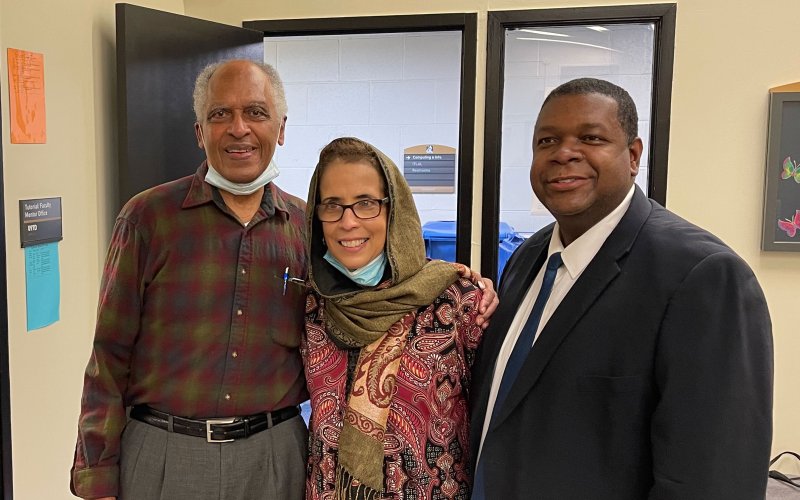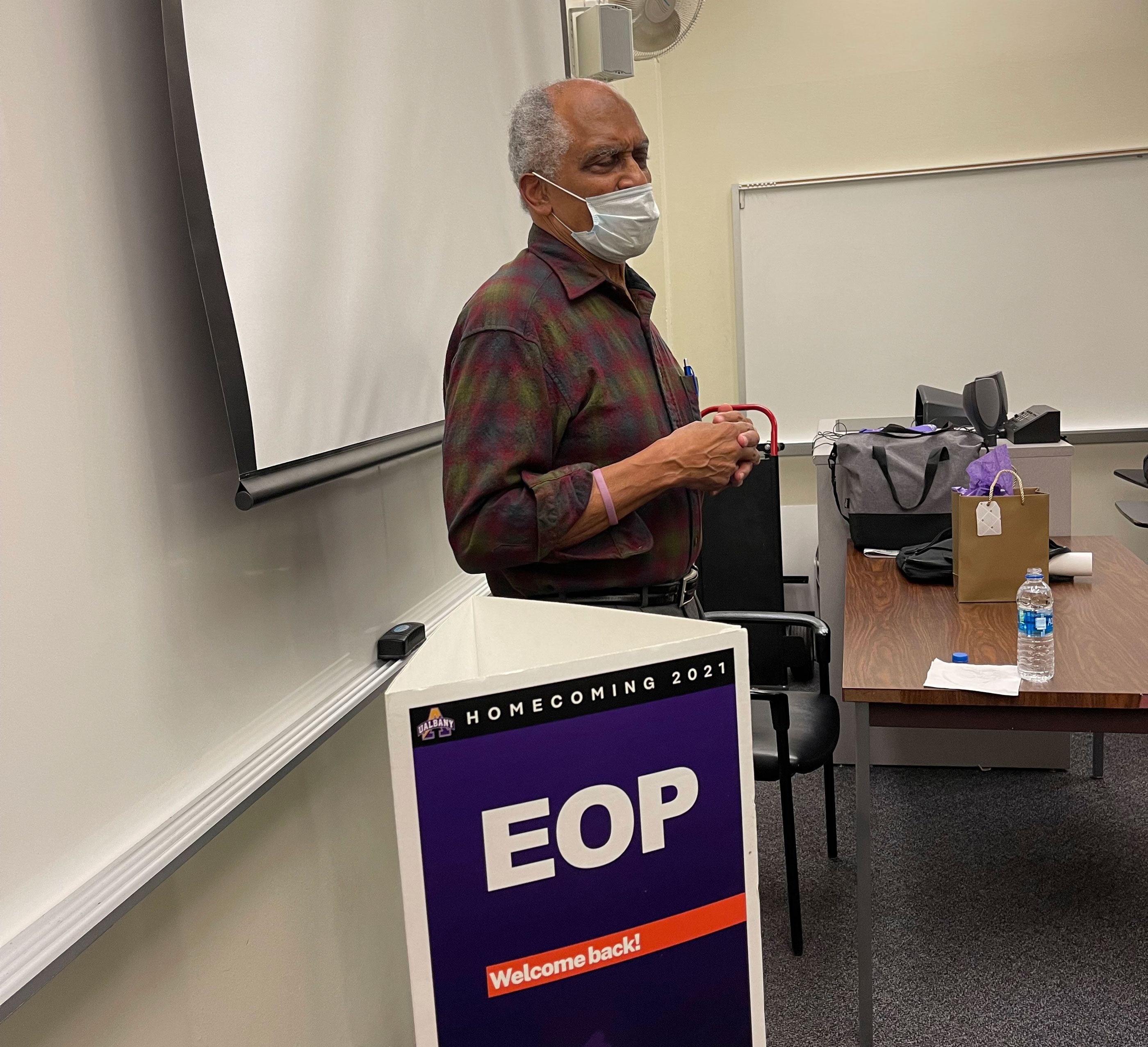UAlbany EOP's First Director Reflects on Program's Past and its Enduring Success

While the world continues to celebrate the American origin story through Broadway’s lively lens of “Hamilton,” another Hamilton recently entered the spotlight in UAlbany’s EOP complex to celebrate another origin story. Dr. Harry Hamilton was the first director of the University’s Educational Opportunity Program, serving from 1968 to 1971, before returning to his true calling as a professor in the Department of Atmospheric and Environmental Sciences.
While no blood was shed or troops mustered, as in 1776, the founding of the EOP, now in its 53rd year, was not without its high drama, tension, or conflict. The late 1960s was an era in which “battle lines were being drawn,” and a program with such an egalitarian premise was sure to rub some in higher education the wrong way.
Present at Hamilton’s Nov. 18 talk was George Keleshian ’73, who immigrated here from Lebanon when he was 10. Now, Keleshian is the CEO of Zeroenergy Buildings of Guilderland, but in 1970 he was one of the leaders of a group of SUNY students protesting proposed cutbacks to the EOP. They put chains on the room in the State Education Building where Hamilton was negotiating with state officials who wanted to implement those cutbacks. The chains forced them to stay longer than they had expected, but Hamilton said the officials would have come around, chains or no chains. At any rate, the officials gave in, and the EOP funding survived the cuts.
“If I’d known George was going to be here, I probably wouldn’t have come,” Hamilton said. “We like to rib each other -- I go back with George many years. We survived a couple skirmishes with the administration.” He called the State Education Building on Washington Avenue “the most imposing building you can see in Albany. Some of our funding came from there and they tried to jerk us around because I didn’t fill out some of the forms the way they thought I should.”
The first EOP class consisted of 175 entering freshmen.

“The only criterion was that they had the brains and determination to succeed at the University,” Hamilton told an assembled group of students and staff in an EOP classroom. “The only thing wrong was they didn’t have the same scores as the other 2,000 students coming in. So, as you can imagine, there were a lot of professors who said that’s a bunch of nonsense – when we had the smartest entering class of any of the University Centers, some of the highest scores in the country, and you want to bring in students that don’t have those same numbers? It’s an utter failure.”
Hamilton said the only thing the EOP had going for it was that he, Harry Hamilton, believed in it.
“Don’t think I’m telling you this to make Harry look good,” he said. “But I had all the right credentials. The faculty couldn’t argue I was peddling an inferior product. I came from one of the best universities, the University of Wisconsin; I came from a science program; I was Phi Beta Kappa, which seemed to indicate I had some smarts. And everywhere I went I said, ‘Just do what we tell you to do.’ And it worked.
“Every day we were inventing new things to incorporate and ensure success for our students,” he said. “There was no manual to say, ‘This is what you do to run a program. We just needed a group of instructors and counselors, and a couple of administrators to say, ‘This is what this program needs.’ From the very outset, the goal was to graduate students from (UAlbany). It was not to give them some college courses – success for us was out the door in four to five years. So that’s what we worked for, inventing every day, having arguments with the establishment every week, overcoming their reluctance, and we did it.”
Hamilton said he had come from an activist family in Wisconsin, “so I knew that good things don’t happen, good things are made to happen.”
UAlbany’s EOP still has about the same number of students it did back in those days. Another thing that hasn’t changed is the space it occupies. Hamilton said he was told the EOP would be given a vacant space in the library basement.
“I was told, ‘That’s gonna be where your space is. Here’s a piece of paper, a ruler, and a pencil. Now design this space.’ This is hard to believe, 53 years ago, and this is the space I designed – it’s still here.”
After his talk, Harry followed outgoing EOP Director Maritza Martinez into the main office. He noted that when he was director, his office was where the staff break room is now – this arrangement continued through the directorship of Carson Carr.
“In my heart, I will always be EOP, because I believed, our staff believed and our students believed, and we will never know how many people have benefited from EOP,” Hamilton said. “Some people say if you admit a student and that student doesn’t make it past the first year, what a failure that is. I said that is the most nonsense I have heard of. That student has been here, they’ve interacted with other students, they’ve interacted with faculty, they have gained all kinds of skills and attitudes in one year, so it was worth having that student for one year. But we bring them here to have the four years experience, to walk across that stage with a funny hat and get that little piece of paper that says bachelor's degree. That’s what I want for all of you.”
Harry Hamilton’s Origin Story
Harry Hamilton set the UAlbany EOP rolling because he believed in education for all, not just the privileged few and not just for people of a paler hue, and this belief comes from nowhere strange.
In Madison, Wisconsin, many young people attend the Velma Hamilton Middle School. It was named for Harry Hamilton’s mother. She taught English at the Madison Vocational and Adult School and was the only full-time Black teacher in the city at the time. But that school was not part of the public school system — there were no Black teachers in the Madison school system, her husband, Harry Hamilton Sr., father of the founder of UAlbany’s EOP, told a reporter for Madison’s Capital Times in 1961.
At the time of the article, Harry Hamilton Jr. was 22 and a recent graduate of Beloit College, working on a doctorate in meteorology at the University of Wisconsin. His one sister, Patricia, 19, was a Beloit sophomore majoring in international relations, and his other sister, Muriel, 17, was considering Oberlin College.
While at Beloit, Patricia Hamilton became the first Black woman pledged to the Delta Gamma sorority. This caused the national sorority to suspend the Beloit chapter. “Delta Gamma suspends Beloit unit for pledging Madison Negro girl,” read a news headline from United Press International. In reaction, the University of Wisconsin banned the sorority from its campus, which in turn led to a large protest by sorority and fraternity members. The Beloit chapter founded an independent sorority, Theta Pi Gamma.
The Hamilton family had migrated to Madison from Alabama, choosing Madison because it offered more educational opportunities than they would have found in the South, and because there was less prejudice and discrimination in the northern city. At the time, Velma Hamilton said they could participate directly in community affairs in Madison, whereas in a city like Chicago, “Negro participation for the most part is limited to the Negro community.”
She served on the Governor’s Commission on Human Rights and the Wisconsin Committee for Children and Youth. Harry Hamilton Sr. — a soil scientist at the University of Wisconsin and editor of two research journals — was president of the Madison Chapter of the United World Federalists and served on the board of the NAACP.
But despite the city’s advantages, he was critical of race relations in Madison as well. There were few professionals among the small Black population, “but the worst aspect … is the discrimination in housing,” he said at the time. “As a case in point, there’s a Negro airman out at Truax who lives in his trailer 35 miles from the base because he couldn’t find a trailer park here in the Madison area that would accept him.”
He said there was “considerable defeatism in the Negro community. Too many of our people drop out and never finish high school. They often aren’t prepared for good jobs. But we can’t feel sorry for ourselves. We don’t need sympathy. We need more skills, more professionals.”
It is this background that molded what became Dr. Hamilton’s mission to not only create the EOP at the University at Albany, but to put in place all of the necessary resources so its students could succeed. After 53 years, Dr. Hamilton was pleased to see that, in 2021, the mission and the level of dedication to make the mission a reality had not changed.
This article was written by John Mason, an English & Writing Professor for UAlbany EOP.


